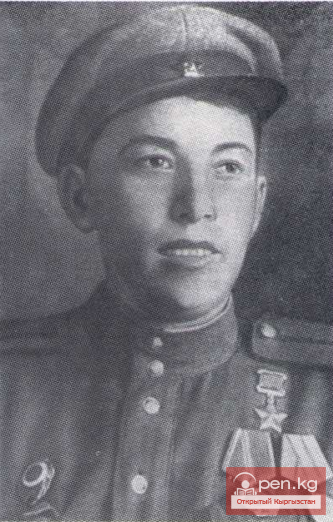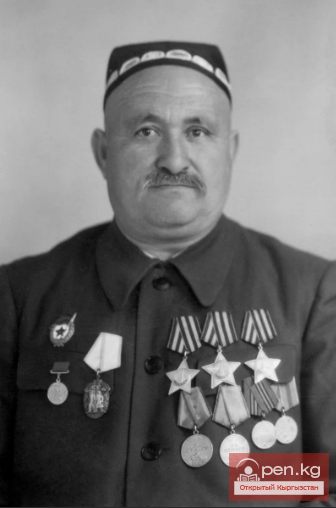
Hero of the Soviet Union Ivan Spiridonovich Nemtev
Ivan Spiridonovich Nemtev was born in 1924 in the village of Bystrovka, Kemin District, Kyrgyz SSR, in a family of a stonecutter. He was raised in an orphanage. Russian. Member of the Communist Party of the Soviet Union. Before the war, he worked as a laborer in the mechanical workshops of the Ak-Tyuz mine. He served in the Soviet Army from March 1942. Sergeant. Commander of a machine gun squad.
He participated in the Great Patriotic War as part of the Steppe Front. His combat glory came in the summer of 1943 during offensive battles near Belgorod.
By the decree of the Presidium of the Supreme Soviet of the USSR dated November 1, 1943, for his courage and steadfastness, he was awarded the title of Hero of the Soviet Union.
Ivan Spiridonovich went through a long and glorious path. He participated in the battles for the liberation of Poltava and Kremenchug, crossed the Dnieper, Southern Bug, Dniester, and Prut rivers, and became an officer.
After the Victory, he remained in the service of the Soviet Army, and later, with the rank of lieutenant colonel, he was demobilized and returned to his homeland, continuing to work.
A MAN FROM LEGEND
Legends circulated about Ivan Nemtev in the units of the Steppe Front. Soldiers told stories that there was a machine gunner in the 53rd Army who, like a fairy-tale hero, mercilessly mowed down fascists.
Legends aside, this was generally true. Ivan Spiridonovich Nemtev was indeed a famous man and was the pride of the 116th Red Banner Order of Kutuzov Kharkov Rifle Division. It is worth recalling one curious circumstance: after those famous battles near Belgorod, Nemtev ended up in a hospital and was then assigned to another division of the same army. And one day, right at the field kitchen where lunch was being served, an officer from his native division arrived and, seeing Ivan Nemtev, took him with him. It turned out that this was the order of division commander Makarov—to find the renowned machine gunner and return him to his 548th regiment.
The general understood that in tough battles, it was necessary to educate young fighters on the remarkable combat traditions of the unit. And what could be better and more illustrative than a living example of courage and bravery? After all, it was about people like Ivan Nemtev that they said: "Miracle heroes".

A concise and popular scientific essay "The Great Patriotic War," prepared by the Institute of Military History of the Ministry of Defense of the USSR and published in 1973. Only the main events, only the names of the most remarkable warriors. But in this one-volume work, on the page dedicated to the victorious finale of the Battle of Kursk, among other famous sons of our Motherland, we see the name I. S. Nemtev.
Perhaps it is from this, the brightest episode in the Hero's biography, that we should start the story about him.
This took place during the offensive battles against the German-fascist troops in the Belgorod direction. On August 3, 1943, during the breakthrough of the enemy's defense in the area of the village of Nepkhayevo, Sergeant Nemtev received a combat task—to identify and destroy enemy firing points on the front line of the enemy's defense in the sector of the advancing rifle company and thereby ensure the breakthrough of the defense in this area. After establishing the location of three enemy firing points, Nemtev, with the start of our artillery preparation, moved with his machine gun to the left flank of the advancing company, approached almost close to the front edge of the enemy's defense, and at point-blank range shot down all these points one by one.
When our units went on the attack, four new enemy firing points immediately opened fire. Seeing this, Sergeant Nemtev, with his squad, made a decisive advance forward and occupied a firing position in a German trench. During the ensuing brief duel, he suppressed two of the enemy's machine gun positions, and then shot down the crews of the other two. The fascists began to retreat in panic to new defensive lines. Noticing this, the machine gunners shifted their fire and struck the retreating infantry, destroying even before the platoon of Hitler's troops. The decisive and skillful actions of the brave machine gun commander allowed our rifle units to quickly break through the line of defense and organize the pursuit of the retreating enemy.
On August 4, in the battles for the height of Bezimyannaya, Sergeant Nemtev, under the cover of night darkness, pulled his machine gun up to the enemy trenches and at dawn opened sudden flanking fire along the trench, destroying up to half a platoon of Germans and capturing seven men.
Having pulled up reserves, the enemy launched a counterattack with forces of up to a company. Allowing the attackers to come within 40-50 meters, the machine gunners began to fire at close range at the advancing enemies. Wounded in the head, Ivan did not leave the battlefield. His squad destroyed up to two platoons of Hitler's troops and thwarted their counterattack. Bleeding profusely, Nemtev, along with his soldiers, repelled a second counterattack: another platoon of enemy infantry lay dead before their positions. He was wounded again in the arm. Only after the assigned combat task was completed and the success of the offensive was ensured for our rifle units did the brave warrior go to the medical battalion...
By the decree of the Presidium of the Supreme Soviet of the USSR dated November 1, 1943, for exemplary fulfillment of combat tasks from the command on the front against the German-fascist invaders and for the courage and heroism displayed therein, Sergeant Ivan Spiridonovich Nemtev was awarded the title of Hero of the Soviet Union, with the award of the Order of Lenin and the medal "Gold Star" (No. 1328).

After the war, I.S. Nemtev continued his service in the army. In 1945, he graduated from the Riga Military-Political School, and in 1961, he completed the "Shot" courses. Since 1968, Lieutenant Colonel I.S. Nemtev has been in reserve.
He lived in the capital of Kyrgyzstan – the city of Frunze (now Bishkek). In 1969-1970, he was the head of the Traffic Police of the Ministry of Internal Affairs of the Kyrgyz SSR, and then worked as the head of the transport department at the woolen and cloth combine.

He died on December 13, 1997. He is buried at the Southwest Cemetery in Bishkek.














































